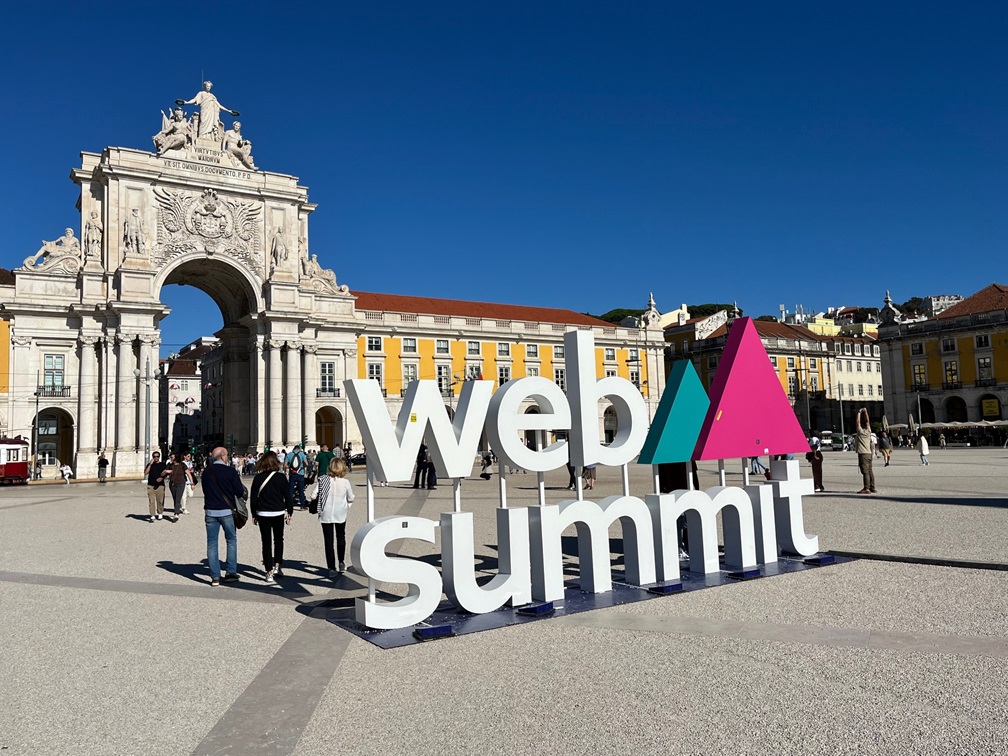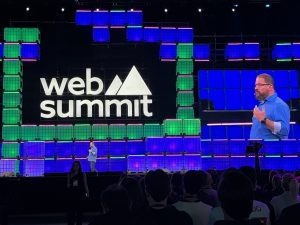 AI
AI
 AI
AI
 AI
AI
The rocket-powered growth of global adoption of artificial intelligence is accompanied by a paradox: Although the technology has generated tremendous optimism for its potential to positively transform whole sectors of society, AI has also triggered alarm bells over damage to trust and governance.
Even a top executive for Microsoft Corp., which has as much invested in AI as any company today, acknowledged concerns around what this next wave of industrial transformation may bring.
“Part of our work as a community is to build out an AI governance machine,” Microsoft President Brad Smith, said during a presentation at Web Summit in Lisbon on Tuesday. “We need to build an industrial revolution that is sensitive to the needs of the planet.”
The contrast surrounding AI’s impact on business innovation and efficiency and its potential societal cost was one of the clear themes to emerge from this year’s Web Summit gathering, which attracted more than 70,000 attendees over three days in the capital of Portugal. Sessions highlighted how AI is impacting cloud industries, robotics and the basic ways that users interact with technology.
One of the participating companies, Qualcomm Inc., is at the forefront of the AI wave, designing chip systems to leverage increasingly more powerful central processing units and graphics processing units to train large language models. The company’s Snapdragon Elite 8’s AI Engine powers the CPU and GPU alongside a neural processing unit for initiating AI workloads.

Cristiano Amon, CEO of Qualcomm, spoke about AI this week at the Web Summit in Lisbon.
During his presentation at Web Summit, Qualcomm Chief Executive Cristiano Amon characterized generative AI as the new user interface, explaining that AI’s natural language capability has removed the wall between human and machine.
“Gen AI is the new UI, now the humans can speak to the computing using human language,” Amon told the Web Summit gathering this week. “It’s a new paradigm shift that creates a whole new opportunity to create value. Apps are going to change to a human-first type of experience.”
Ironically, AI’s ability to create a human-first experience is also putting a turbo charge into the field of robotics. Thomas Wolf, co-founder and chief science officer of the popular open-source AI model repository Hugging Face Inc., noted that robotics was poised to experience new growth in the months ahead, fueled by the rise of small language models.
“You need low latency for robotics, and we see smaller models as part of that,” Wolf explained. “It’s just a question of compute size and speed. AI will be embedded everywhere.”
An example of how smaller models have been transforming robotics was provided on Wednesday by Peggy Johnson, CEO of Agility Robotics Inc. She was joined during her appearance by Digit, the firm’s humanoid robot, which sorted laundry onstage in response to verbal commands. Agility’s robot is given actual use cases for different workflows, and is capable of performing one task in the morning and another in the afternoon.
Digit is programmed to flash hearts in its eyes when asked to express love for something, but Johnson discovered one instance when Digit responded to the prompt by arranging objects on a table in front of it into the image of a heart instead. Agility uses a variety of AI models to train its robot, and the switch was a function of which model it was trained on. “The different AI models will react differently,” Johnson said.
The platforms required to train AI models are also experiencing a competitive transformation. Though hyperscalers such as Google LLC, Microsoft and Amazon Web Services Inc. have captured a healthy share of the AI compute market, cloud operator CoreWeave Inc. has positioned itself as an optimized alternative for AI workloads.
On Wednesday, the company announced that it had closed a $650 million secondary funding round, which was joined by Cisco Investments and Pure Storage Inc., along with several financial institutions. CoreWeave operates data centers powered by AI clusters that include up to tens of thousands of Nvidia Corp. GPUs.
“The legacy cloud built the minivan,” CoreWeave CEO Michael Intrator said during a main stage appearance at Web Summit on Wednesday. “But when you’re building AI infrastructure and serving labs and companies built around AI, they have a specific use case. They want to access compute in the most effective way. Our opportunity to compete with the hyperscalers is by providing an entirely different product.”
While the tech industry’s focus has been on building out AI infrastructure and advancing model applications, its also being confronted with the consequences of what rapid innovation can bring.
AI’s robust language training enables it to understand human conversations. This has proved to be a powerful tool on social media platforms where algorithms can amplify specific messages aimed at targeted audiences.
The independent research organization NewsGuard has identified more than 1,100 AI-generated news outlets, spanning 16 languages, including English, and operating with virtually no human oversight. NewsGuard has also recently reported that fake news sites now outnumber real newspaper sites in the U.S.
This places the focus squarely on social media companies which are providing a robust platform for disseminating misleading information, according to Jan Rezab, founder and CEO of Ravineo, a digital media company which launched Tuesday. Rezab, an angel investor who previously led the analytics firm Socialbakers, is encouraging social media platforms to open their news algorithms for inspection in an effort to prevent manipulation of public opinion by completely fictious organizations.
“News algorithms should be completely transparent,” Rezab said in an interview with SiliconANGLE. “It’s the most dangerous weapon that’s ever been handed to society.”
Concerns about the influence of AI in online news and social media are also shared by mainstream media leaders such as The Atlantic CEO Nicholas Thompson. In May, his 167-year-old publication announced a business partnership with OpenAI, a deal described in an Atlantic story headline as “A Devil’s Bargain With OpenAI.”
Speaking at a Web Summit session, Thompson expressed his belief that the realities of the news business required adoption of new technologies to remain relevant and competitive, while casting a wary eye at the growing influence of AI in content publishing. “The scenario that I worry about the most is that AI basically turns the web to garbage,” Thompson said.
It’s not only media publishers who are expressing concern about AI’s future impact. Michael O’Flaherty, Commissioner of Human Rights for the Council of Europe, spoke about the potential for AI’s widespread adoption to affect human rights commitments made by the countries in his organization.
“It’s dangerous too, it’s tricky stuff,” O’Flaherty said. “We need guardrails. It’s about prevention, not chasing after everything that went wrong. It’s protecting the dignity of every human being, and we need to be sure that AI delivers on that.”
Looming over the Web Summit conversation this week was the future impact of a new government in the U.S. next year. A number of speakers were cautiously optimistic that the incoming Trump administration would be favorably disposed toward both business in general and the tech sector in particular.
However, the American actor Richard Schiff, who received an Emmy award for his role in “The West Wing,” a television series about day-to-day operations in a fictional White House, was not so sure. Schiff expressed a note of concern about the influence of Tesla, X and SpaceX leader Elon Musk, who has become a prominent figure in the President-elect’s administration.
“The most important tech person in the world has now become the shadow vice president,” Schiff said.
Support our mission to keep content open and free by engaging with theCUBE community. Join theCUBE’s Alumni Trust Network, where technology leaders connect, share intelligence and create opportunities.
Founded by tech visionaries John Furrier and Dave Vellante, SiliconANGLE Media has built a dynamic ecosystem of industry-leading digital media brands that reach 15+ million elite tech professionals. Our new proprietary theCUBE AI Video Cloud is breaking ground in audience interaction, leveraging theCUBEai.com neural network to help technology companies make data-driven decisions and stay at the forefront of industry conversations.